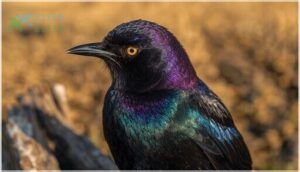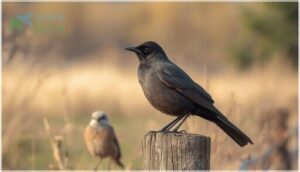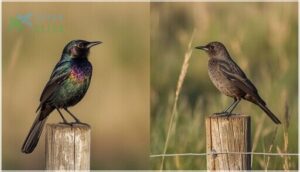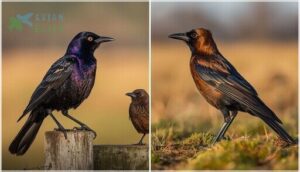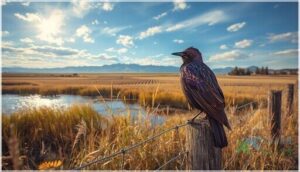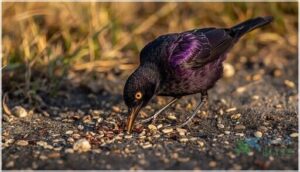This site is supported by our readers. We may earn a commission, at no cost to you, if you purchase through links.

These adaptable birds don’t just survive in our altered landscapes—they’ve claimed them, from coastal wetlands to shopping center lawns. Yet despite their success at living near us, their numbers have plummeted by 57% since 1966, a decline that’s gone largely unnoticed.
Understanding how to identify these metallic-sheened birds and what makes them tick reveals both their striking resilience and the quiet conservation crisis unfolding in our backyards.
Table Of Contents
- Key Takeaways
- Brewer’s Blackbird Appearance and Identification
- Habitat and Distribution Across North America
- Diet and Feeding Behavior
- Breeding and Nesting Habits
- Conservation Status and Ecological Role
- Frequently Asked Questions (FAQs)
- Are brewers blackbirds rare?
- How do you identify a Brewer’s Blackbird?
- Where do Brewer’s blackbirds live?
- What is the difference between a Brewer’s Blackbird and a grackle?
- What sounds do Brewers Blackbirds make?
- Are Brewers Blackbirds migratory birds?
- How do Brewers Blackbirds interact with humans?
- What are the primary threats to Brewers Blackbirds?
- How do Brewers Blackbirds affect their ecosystem?
- How long do Brewers Blackbirds typically live?
- Conclusion
Key Takeaways
- Brewer’s Blackbirds are highly adaptable medium-sized songbirds with distinctive yellow eyes in males and glossy purple-green iridescent plumage, but their population has declined by 57% since 1966 despite their “Least Concern” conservation status.
- These birds thrive in both wild and human-modified habitats across western North America, from wetlands to parking lots, and shift their diet seasonally between insects in summer (60%+ of intake) and seeds in winter (80%+ of intake).
- While they provide valuable ecosystem services like pest control by consuming agricultural insects and dispersing seeds, they face mounting threats from habitat loss, pesticide exposure, climate change, and high nest predation rates reaching 63% in some areas.
- The species demonstrates partial migration patterns where northern populations travel up to 1,500 miles south while western coastal birds remain year-round, with breeding occurring in loose colonies of 6-30 pairs near water sources from March through August.
Brewer’s Blackbird Appearance and Identification
If you’ve ever spotted a sleek black bird with glowing yellow eyes strutting across a parking lot, you might’ve met a Brewer’s Blackbird. These medium-sized songbirds have a look that’s easy to recognize once you know what to watch for.
Let’s break down the key features that’ll help you pick them out from other blackbirds in the field.
Male Plumage and Eye Color
With their glossy black feathers catching sunlight, male Brewer’s Blackbirds show off a striking violet-purple iridescence on the head and bluish-green sheen across the body. You’ll notice their bright yellow eyes—a standout feature. This iridescent plumage results from microscopic feather structures that refract light, not pigment, and peaks during breeding season when testosterone boosts plumage maintenance and brilliance. They’re often found in open Illinois habitats, such as plowed fields.
- Structural coloration creates the metallic hues through light refraction rather than pigments
- Yellow irises develop fully within the first year, changing from juvenile brown eyes
- Older males display deeper spectral peaks in violet and green bands compared to younger adults
Female and Juvenile Features
Unlike their flashy male counterparts, female Brewer’s Blackbirds wear uniform gray-brown plumage without iridescence—just simple, flat tones. You’ll spot dark brown eyes instead of yellow. Juveniles look similar but paler and duller overall.
Female and juvenile plumage lacks streaks or spots, making field identification straightforward. Both average 22 cm long and weigh 50–67 g. Juveniles morph to adult-female coloration after their first molt, usually within twelve months.
This species is classified as Least Concern on the IUCN Red List.
Size, Shape, and Distinguishing Traits
You’ll recognize a Brewer’s blackbird by its robin-sized body—males measure 21–25 cm, females 20–22 cm—and well-proportioned build. Body proportions include rounded heads, long legs, and especially long tails that widen at the tip. The cone-shaped bill morphology is thick-based and sharply pointed.
Sexual dimorphism shows in size and iridescence patterns: males display glossy purple-green plumage, while tail variations and upright posture aid Brewers blackbird identification across habitats.
Seasonal Plumage Variations
Throughout the year, you’ll notice Brewer’s blackbird plumage shifts as feathers wear and molt timing occurs. Males complete a full prebasic molt between July and September, renewing their breeding plumage with peak male iridescence by spring. Meanwhile, female uniformity remains consistent year-round. Here’s what changes seasonally:
- Fresh fall feathers show brownish fringing that wears off by spring
- Juvenile development happens after fledging, mostly complete by late summer
- Feather wear from sunlight and abrasion reduces gloss through winter
- Seasonal plumage differences are most dramatic in first-year males
Common Identification Mistakes
Why do so many birders confuse Brewer’s blackbirds with grackles? Size differences and tail shape prove tricky—grackles measure 1.5 times larger with keel-shaped tails, but you can’t always tell without direct comparison.
Eye color also trips people up: males show yellow eyes, females brown. Female confusion runs high too, since brown plumage resembles cowbirds.
Check field marks carefully in mixed flocks to nail Brewers blackbird identification.
Habitat and Distribution Across North America
Brewer’s Blackbirds occupy a broad swath of North America, from the Great Lakes westward to the Pacific coast and stretching into southern Canada and Mexico. These adaptable birds thrive in diverse environments, from natural wetlands and grasslands to city parks and farm fields.
Understanding where they live and how they move throughout the year will help you spot them in your own area.
Breeding and Wintering Ranges
You’ll find Brewer’s Blackbirds breeding across western North America, from southern British Columbia through the Great Basin to northern New Mexico. Their impressive range expansion pushed nearly 1,200 km eastward into Michigan by 1950.
During winter, migration patterns shift southern populations into Texas and Mexico, while western birds often stay put. Climate impacts may force future range shifts northward, with projections showing over 70% habitat loss by 2080.
Preferred Ecosystems and Elevation
From Death Valley’s basin floor, 200 feet below sea level, to Sierra Nevada meadows above 11,000 feet, you’ll encounter Brewer’s blackbirds across striking elevation adaptations. Their habitat selection favors open habitats like grasslands, marshlands, and sagebrush ecosystems.
These birds thrive in agricultural lands and habitat distribution patterns show breeding densities peaking in the Great Basin. Seasonal shifts drive northern populations toward lower elevations, while western birds maintain year-round territories.
Adaptation to Urban and Agricultural Areas
You’ll spot Brewer’s blackbirds thriving where humans have reshaped landscapes—city parks, golf courses, and croplands become prime urban nesting sites. Their adaptability shines through agricultural foraging habits, where flocks exploit waste grain and insects near feedlots.
This dietary flexibility lets them switch between ground gleaning and aerial hawking within hours. Agricultural impact remains minimal despite their presence, while population outcomes show 23 million birds benefiting from human-modified open habitats.
Migration Patterns
Brewers Blackbird migration patterns split populations into distinct travelers and year-round residents. Central North American birds journey up to 1,500 miles southward each fall, while Pacific Coast populations stay put.
Spring migration peaks between late April and early May across Montana, with fall movements cresting in early October. Temperature drops below 5°C trigger these seasonal timing shifts, shaping geographic range adjustments across the distribution range throughout North America.
Diet and Feeding Behavior
Brewer’s Blackbirds aren’t picky eaters, and that flexibility has helped them thrive in both wild and human-dominated landscapes. Their diet shifts with the seasons, taking advantage of whatever food sources are most abundant at the time.
Let’s look at what these adaptable birds eat, how they find their meals, and some of their more unusual feeding habits.
Primary Food Sources and Seasonal Changes
You’ll notice the Brewers Blackbird diet shifts dramatically with the seasons. During spring and summer breeding months, insects dominate—over 60% of their intake includes grasshoppers, beetles, and caterpillars.
Come fall and winter, these avian opportunists switch gears, with seeds and grains making up roughly 80% of food sources. This seasonal shift reflects both insect availability and nutritional impact on survival and reproduction.
Foraging Strategies and Techniques
Understanding what these birds eat leads naturally to how they get their food. You’ll find Brewer’s Blackbirds using diverse foraging habits: they walk steadily across open ground scanning for insects, occasionally launch into aerial hunting to snatch flying prey, and gather in flock foraging groups outside breeding season.
Their opportunistic feeding extends to wading through shallow marshes and following farm equipment to exploit freshly turned soil.
Impact on Croplands and Human Areas
You’ll encounter Brewer’s Blackbirds as both helpers and hassles around farms and cities. They consume beneficial insects during summer, reducing pest populations and pesticide needs. However, their flocks cause crop damage—about 2% of sunflower yields in northern states—and feedlot impacts through feed spillage.
In urban areas, large winter roosts create noise and droppings, prompting mitigation strategies like habitat modification and alternative feeding sites near fields.
Unique Feeding Behaviors (e.g., Anting)
Beyond typical ground foraging, you’ll notice Brewer’s Blackbirds performing anting—allowing ants to crawl over their feathers or rubbing crushed ants into plumage. This releases formic acid that controls parasites and cleans feathers.
Their dietary opportunism extends to kleptoparasitism tactics, stealing food from gulls, and even hawking flying insects mid-air. Social foraging groups locate invertebrates efficiently, demonstrating striking feeding adaptability across varied habitats.
Breeding and Nesting Habits
Brewer’s Blackbirds follow fascinating patterns regarding raising their young, from where they build their nests to how they care for their chicks. Understanding these breeding habits gives you insight into their seasonal behavior and social structure.
Let’s look at the key aspects of their nesting cycle.
Nest Construction and Colony Formation
You’ll find Brewer’s Blackbird nesting colonies ranging from a few pairs to over 100, usually settling near water sources like ponds or wetlands. Females construct cup-shaped nests using plant stems, twigs, dried grasses, and mud, taking roughly 5-10 days to complete.
These nests, measuring about 6 inches across, sit in shrubs or trees 20-40 feet high. Colony nesting helps defend against predators through coordinated mobbing behaviors.
Egg Laying, Incubation, and Fledging
After completing the nest, females lay 3-7 eggs—averaging around 5—with pale blue to greenish coloration marked by reddish-brown speckles. Each egg measures roughly 1 inch long.
Key nesting and reproduction milestones include:
- Incubation period: 12-14 days, handled solely by females
- Hatching success: approximately 53-63% depending on location
- Fledgling survival: young leave nests at 13-14 days, with early survival rates around 50-58%
Clutch size and incubation duration vary slightly based on environmental conditions.
Parental Care and Brood Frequency
Both parents share nestling care, making frequent feeding trips throughout the day. Young depend on adults for up to 85 days post-fledging—a surprisingly long period compared to many songbirds. Brewers Blackbird pairs generally raise one brood annually, though favorable conditions sometimes enable a second attempt.
| Parental Care Aspect | Details |
|---|---|
| Nestling provisioning | Both sexes feed young multiple times daily |
| Fledgling dependence | Up to 85 days after leaving nest |
| Multi-brooding frequency | 1-2 broods per season |
| Nesting success rate | Approximately 40% overall |
| Primary brood failure cause | Predation (63-90% of losses) |
Parental roles remain intensive even after eggs hatch, ensuring survival despite modest success rates.
Breeding Season Timing and Locations
From March through early August, you’ll notice Brewer’s Blackbird nesting season in full swing across North America. Geographic timing variation means southern populations start breeding earlier, while northern and high-elevation birds delay until May or June. Nesting site preferences depend heavily on latitude environmental influence and local conditions.
Colony breeding synchrony and preferred nesting sites include:
- Riparian zones and wetland edges with shrubs 6-12 meters high
- Urban parks, agricultural fields, and golf courses
- Loose colonies of 6-30 pairs near reliable water sources
- Minnesota’s northern counties document 284 breeding locations
- Colorado records confirm nesting activity from April 19 to August 22
Synchronized egg-laying within colonies improves survival rates during the nesting period.
Conservation Status and Ecological Role
The Brewer’s Blackbird currently holds a “Least Concern” status, but its population has been quietly declining across parts of its range. Understanding where this species stands today helps you see the bigger picture of how these birds fit into their ecosystems and what challenges they face.
Let’s look at their conservation status, the threats they encounter, and the role they play in the environment.
IUCN Status and Population Trends
You might be surprised to learn that despite the Brewer’s Blackbird’s IUCN Red List classification as “Least Concern,” its population has plummeted by roughly 57% since 1966. North American Breeding Bird Survey data shows an average annual decline of 2–2.25%, totaling over 61% loss between 1970 and 2014.
Despite their Least Concern status, Brewer’s Blackbird populations have crashed 57% since 1966, losing over 61% between 1970 and 2014
Regional Trend Variations exist—Great Plains populations remain stable while western numbers continue falling, prompting Conservation Reassessment Urgency as Habitat Loss Impact and climate change worsen.
Threats and Human Impacts
You’re witnessing habitat degradation from wildfires, urban sprawl, and climate change shrinking their range by up to 25%.
Agricultural conflicts arise when flocks consume grain and contaminate feedlots, costing farmers millions. Pesticide exposure—like neonicotinoids—thins eggshells and reduces prey.
Disease transmission risks include salmonellosis and mosquito-borne viruses. Despite their “Least Concern” IUCN Red List status, these combined threats accelerate population decline.
Predators and Ecosystem Contributions
Hawks, owls, crows, and raccoons prey heavily on Brewer’s Blackbirds, with nest predation reaching 63% in some habitats, directly affecting their conservation status.
Yet, these birds play a crucial role in balancing ecosystems through pest control, consuming weevils and cutworms that damage crops. Their seed dispersal also aids in plant regeneration.
Despite a 57% population decline since 1966, Brewer’s Blackbirds continue to maintain ecosystem balance by curbing agricultural pest outbreaks and integrating into urban food webs.
Conservation Efforts and Future Outlook
Agencies like the U.S. Fish & Wildlife Service and Audubon Society are backing habitat restoration and population monitoring programs that benefit Brewer’s Blackbirds. These conservation efforts focus on threat mitigation through wetland protection and agricultural habitat management.
While conservation funding underwrites measurable goals like habitat acreage targets, future research remains critical to understanding population trends and reversing the species’ declining conservation status.
Frequently Asked Questions (FAQs)
Are brewers blackbirds rare?
No, Brewer’s Blackbirds aren’t rare. Conservation status lists them as Least Concern, with a population size around 23-24 million individuals. Despite population decline since 1966, their habitat adaptability maintains regional abundance across North America.
How do you identify a Brewer’s Blackbird?
Like spotting a dark jewel in sunlight, you’ll notice males by their glossy black plumage with purple-green iridescence and bright yellow eyes, while brownish-gray females show dark eyes and subtle hints of sheen.
Where do Brewer’s blackbirds live?
You’ll find them throughout western and central North America—from British Columbia to Mexico—thriving in open habitats like wetlands, grasslands, and agricultural fields.
Their range expansion includes urban adaptation despite ongoing habitat loss and climate impact challenges.
What is the difference between a Brewer’s Blackbird and a grackle?
You might spot a glossy black bird and wonder which species you’re seeing. Brewer’s blackbirds are smaller with shorter tails and straight bills, while common grackles feature longer, wedge-shaped tails and curved bills—key differences in similar species identification.
What sounds do Brewers Blackbirds make?
You’ll hear two main songs from these birds: a sharp, piercing squee and a gurgling rush.
They also produce various calls, including tchup sounds, descending whistles, and rapid kit-tit-tit-tit chatters during different behaviors.
Are Brewers Blackbirds migratory birds?
Yes, Brewer’s Blackbirds are partially migratory. Most western North America populations remain year-round residents, while northern breeders migrate up to 1,500 miles southward in fall, triggered by shortening daylight and temperature changes.
How do Brewers Blackbirds interact with humans?
You’ll spot these bold birds thriving near parking lots, city parks, and croplands—often foraging behind farm machinery for waste grain.
They’re remarkably comfortable around people, though large flocks sometimes create noise and cleanup challenges in urban spaces.
What are the primary threats to Brewers Blackbirds?
You’ll find their bird population facing habitat degradation, pesticide exposure, and climate impacts. Predation increase and human impacts threaten their conservation status.
Bird predators and environmental changes challenge these adaptable blackbirds across North America.
How do Brewers Blackbirds affect their ecosystem?
You’ll notice these blackbirds regulate insect populations while dispersing seeds across grasslands.
They contribute to food webs as prey for raptors, though climate sensitivity threatens their ecological role in pest control and vegetation dynamics.
How long do Brewers Blackbirds typically live?
You’ll find that wild lifespan for these birds generally reaches 10 to 12 years, though predation impact and habitat effects influence survival factors considerably. Maximum longevity records show some individuals exceeding 6 years.
Conclusion
They’re everywhere yet vanishing—that’s the Brewer’s blackbird paradox unfolding in plain sight. You’ve learned to spot those yellow eyes and purple-glossed feathers, but recognition alone won’t reverse their 57% decline.
These birds adapted brilliantly to our world, only to suffer from the very landscapes they conquered. Next time one struts past your car, remember: familiarity doesn’t guarantee survival.
The species thriving in parking lots today might become tomorrow’s cautionary tale about taking commonplace neighbors for granted.

